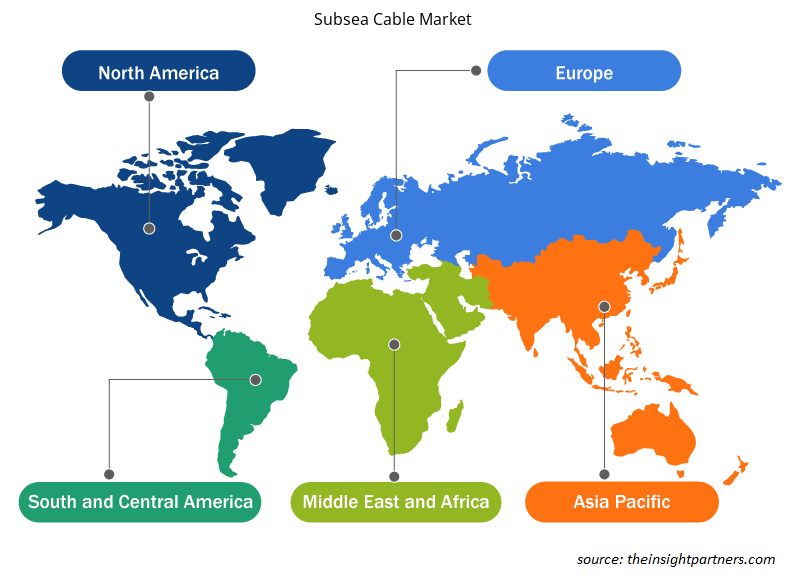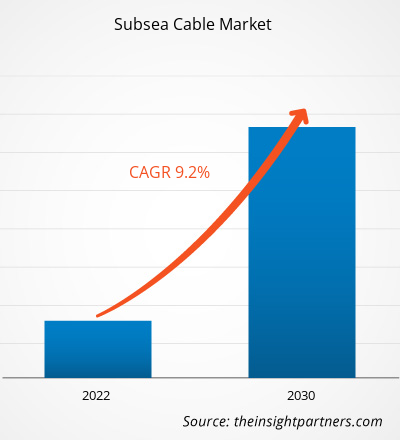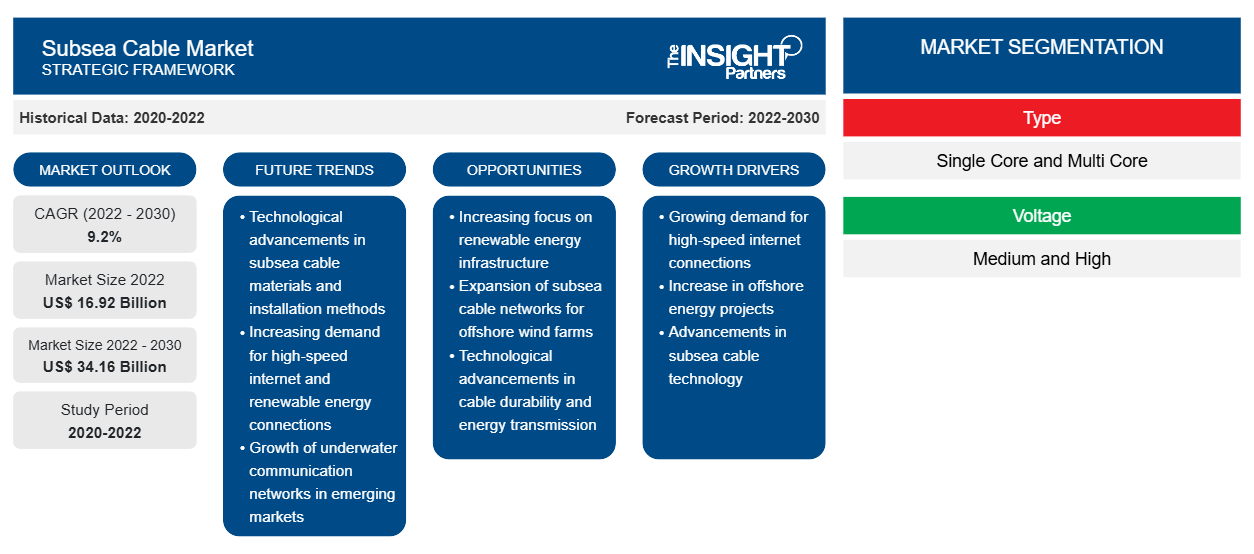[Informe de investigación] El mercado de cables submarinos se valoró en US$ 16,92 mil millones en 2022 y se espera que alcance los US$ 34,16 mil millones en 2030; se estima que registrará una CAGR del 9,2% entre 2022 y 2030.
Perspectiva del analista:
La creciente demanda de Internet y teléfonos inteligentes entre los consumidores, el aumento de las inversiones en nuevos sistemas de cable y la creciente adopción de la tecnología en la nube son algunos de los factores que impulsan el crecimiento del mercado de cables submarinos . Los cables submarinos se utilizan para transmitir rápidamente grandes cantidades de datos y conectar varios países en todo el mundo. Sin embargo, los crecientes ataques de ciberseguridad y el alto costo asociado con la instalación de cables submarinos obstaculizan el crecimiento del mercado. Además, la creciente necesidad de flujo de datos y comunicación está impulsando el crecimiento del mercado en todo el mundo. Además, se prevé que el creciente número de nuevos proyectos relacionados con la instalación de cables submarinos cree varias nuevas oportunidades de crecimiento para el mercado durante el período de pronóstico.
Descripción general del mercado:
Los cables submarinos, también conocidos como cables submarinos, son cables largos de fibra óptica tendidos en el lecho marino que conectan dos o más puntos de aterrizaje. Estos cables tienen miles de kilómetros de longitud y se utilizan para transportar señales de telecomunicaciones de un punto a otro. Los cables submarinos son componentes esenciales de la infraestructura de telecomunicaciones global, como la conexión de continentes, los cables de Internet y la facilitación de la comunicación mundial. Estos cables se utilizan principalmente para el transporte de datos y comunicaciones a distancia, ya que permiten la transferencia rápida de datos a nivel mundial.
Personalice este informe según sus necesidades
Obtendrá personalización en cualquier informe, sin cargo, incluidas partes de este informe o análisis a nivel de país, paquete de datos de Excel, así como también grandes ofertas y descuentos para empresas emergentes y universidades.
-
Obtenga las principales tendencias clave del mercado de este informe.Esta muestra GRATUITA incluirá análisis de datos, desde tendencias del mercado hasta estimaciones y pronósticos.
Conductor del mercado:
El creciente tráfico de Internet impulsa el mercado de cables submarinos
El uso creciente de Internet en todo el mundo está impulsando el mercado global. Según el Atlantic Council, más del 97% del tráfico mundial de Internet depende de cables submarinos, que están aumentando rápidamente. El mundo está conectado a través de Internet y casi todo el mundo depende en gran medida de él para gestionar sus actividades cotidianas, lo que aumenta la necesidad de servicios de Internet entre los consumidores. Según la Unión Internacional de Telecomunicaciones (UIT), el mundo tendrá 5.400 millones de usuarios de Internet a finales de 2023, lo que representa el 67% de la población mundial que utiliza Internet. Existe un rápido crecimiento en la demanda de velocidad de ancho de banda rápida entre los consumidores. Además, la penetración de los teléfonos inteligentes en todo el mundo está aumentando debido al aumento del número de usuarios de Internet. Por ejemplo, según la Asociación GSM, habrá 5 mil millones de usuarios de Internet móvil en todo el mundo para 2025, 8 mil millones de conexiones de teléfonos inteligentes para 2027 y 9,5 mil millones de conexiones móviles para 2030. Por lo tanto, la creciente adopción de teléfonos inteligentes impulsa el tráfico de Internet, lo que impulsa el crecimiento del mercado mundial de cables submarinos.
Segmentación y alcance del informe:
El mercado de cables submarinos está segmentado en función del tipo, voltaje, oferta y aplicación. Según el tipo, el mercado se segmenta en un solo núcleo y núcleo múltiple. En términos de voltaje, el mercado se clasifica en medio y alto. Según la oferta, el mercado de cables submarinos se divide enServicios de instalación y mantenimiento y actualización. Según la aplicación, el mercado se divide en comunicaciones y energía. Por región, el mercado de cables submarinos se segmenta en América del Norte, Europa, Asia Pacífico (APAC), Oriente Medio y África (MEA) y América del Sur (SAM).
Análisis segmental:
En función de la oferta, el mercado se bifurca enServicios de instalación y servicios de mantenimiento y actualización. Se prevé que el segmento de servicios de mantenimiento y actualización se desarrolle a un ritmo significativo durante el período previsto debido al alto costo de la instalación de cables. El mantenimiento y la actualización de cables submarinos generalmente requieren menos tiempo (hasta ocho meses) y son más económicos que las nuevas instalaciones. Además, los cables instalados son un activo valioso para una nación, y la implementación de nuevas tecnologías permite al usuario utilizar el cable original, tanto en términos de diseño como de capacidad.
Análisis regional:
En 2022, la región de Asia Pacífico tuvo la mayor participación en el mercado de cables submarinos. El mercado de Asia Pacífico está segmentado en Australia, China, Japón, India, Corea del Sur y el resto de Asia Pacífico. La región aporta una parte notable del mercado mundial debido a la alta adopción e inversiones en cables submarinos en la región. El aumento de la población en países como China e India aumenta el número de usuarios de Internet en la región, lo que impulsa el mercado. Aproximadamente la mitad del tráfico mundial de Internet lo generan los consumidores, principalmente de Asia Pacífico, lo que está impulsando la demanda de cables submarinos. La creciente necesidad de servicios de Internet más rápidos en la región transpacífica, debido a la limitación de los cables de comunicación submarinos en la región, alienta a los gobiernos a desarrollar nuevos sistemas de cable en la región. Por ejemplo, en julio de 2023, Japón firmó un Memorando de Cooperación (MoC) con la Unión Europea para desarrollar cables submarinos en el Ártico. Estos cables mejoran la conectividad al acelerar el tráfico de Internet en todo el mundo y se espera que estén operativos en 2026.
Además, la región de Asia Pacífico se está convirtiendo cada vez más en un centro de inversiones directas en infraestructura de cables submarinos. Por ejemplo, el sistema de cable de 4/6/8 pares de fibra de 3.200 km entre Chennai y Singapur recibió una inversión de 100.000 millones de dólares de los gobiernos de ambos países para que el cable esté listo para funcionar en 2021. Además, muchos gigantes tecnológicos como Google, Microsoft y Facebook se están asociando con empresas de cables submarinos para el desarrollo de nuevos proyectos. Por ejemplo, en enero de 2022, Google, como inversor, se asoció con AARNet, Singtel, Indosat Ooredoo, SubPartners y Telstra en un nuevo proyecto de cable submarino que conectará Japón con Australia a través de Guam.
Perspectivas regionales del mercado de cables submarinos
Los analistas de Insight Partners explicaron en detalle las tendencias y los factores regionales que influyen en el mercado de cables submarinos durante el período de pronóstico. Esta sección también analiza los segmentos y la geografía del mercado de cables submarinos en América del Norte, Europa, Asia Pacífico, Oriente Medio y África, y América del Sur y Central.

- Obtenga datos regionales específicos para el mercado de cables submarinos
Alcance del informe sobre el mercado de cables submarinos
| Atributo del informe | Detalles |
|---|---|
| Tamaño del mercado en 2022 | US$ 16,92 mil millones |
| Tamaño del mercado en 2030 | US$ 34,16 mil millones |
| CAGR global (2022-2030) | 9,2% |
| Datos históricos | 2020-2022 |
| Período de pronóstico | 2022-2030 |
| Segmentos cubiertos |
Por tipo
|
| Regiones y países cubiertos |
América del norte
|
| Líderes del mercado y perfiles de empresas clave |
|
Densidad de actores del mercado: comprensión de su impacto en la dinámica empresarial
El mercado de cables submarinos está creciendo rápidamente, impulsado por la creciente demanda de los usuarios finales debido a factores como la evolución de las preferencias de los consumidores, los avances tecnológicos y una mayor conciencia de los beneficios del producto. A medida que aumenta la demanda, las empresas amplían sus ofertas, innovan para satisfacer las necesidades de los consumidores y aprovechan las tendencias emergentes, lo que impulsa aún más el crecimiento del mercado.
La densidad de actores del mercado se refiere a la distribución de las empresas o firmas que operan dentro de un mercado o industria en particular. Indica cuántos competidores (actores del mercado) están presentes en un espacio de mercado determinado en relación con su tamaño o valor total de mercado.
Las principales empresas que operan en el mercado de cables submarinos son:
- Nokia
- SubCom, LLC
- Corporación NEC
- Prysmian SpA
- NKT A/S
Descargo de responsabilidad : Las empresas enumeradas anteriormente no están clasificadas en ningún orden particular.

- Obtenga una descripción general de los principales actores clave del mercado de cables submarinos
Análisis de los jugadores clave:
Nokia; SubCom, LLC; NEC Corporation; Prysmian SpA; NKT A/S; Furukawa Electric Co., Ltd.; Hengtong Group Co., Ltd.; Ciena Corporation; ZTT Cable; y JDR Cable Systems Ltd. se encuentran entre los actores clave del mercado de cables submarinos perfilados en el informe.
Desarrollos recientes:
Los actores del mercado están adoptando ampliamente estrategias orgánicas e inorgánicas. A continuación se enumeran algunos de los principales desarrollos recientes del mercado:
- En noviembre de 2022, Reliance Industries Limited recibió la aprobación para desplegar el cable submarino más grande del mundo que conectará Singapur con Europa. Se espera que los dos cables submarinos, India-Europe-Xpress (IEX) e India-Asia-Xpress (IAX), comiencen a funcionar entre 2023 y 2024.
- En diciembre de 2022, la Empresa de Telecomunicaciones de Cuba SA firmó un acuerdo con Orange para integrar el proyecto Arimao con el sistema de cable ARCOS-1 en Cojimar, Cuba. Las empresas también planean poner el proyecto en servicio a finales de 2023.
- En octubre de 2021, NEC Corporation anunció que su subsidiaria OCC Corporation colaboró con Sumitomo Electric Industries Ltd. para desarrollar un cable submarino de fibra óptica de cuatro millones de rupias para Facebook. Este sistema de cable aumenta la cantidad de canales de datos independientes al permitir la tecnología de multiplexación por división espacial (SDM) submarina de próxima generación.
- Análisis histórico (2 años), año base, pronóstico (7 años) con CAGR
- Análisis PEST y FODA
- Tamaño del mercado, valor/volumen: global, regional y nacional
- Industria y panorama competitivo
- Conjunto de datos de Excel
Informes recientes
Testimonios
Razón para comprar
- Toma de decisiones informada
- Comprensión de la dinámica del mercado
- Análisis competitivo
- Información sobre clientes
- Pronósticos del mercado
- Mitigación de riesgos
- Planificación estratégica
- Justificación de la inversión
- Identificación de mercados emergentes
- Mejora de las estrategias de marketing
- Impulso de la eficiencia operativa
- Alineación con las tendencias regulatorias























 Obtenga una muestra gratuita para - Mercado de cables submarinos
Obtenga una muestra gratuita para - Mercado de cables submarinos